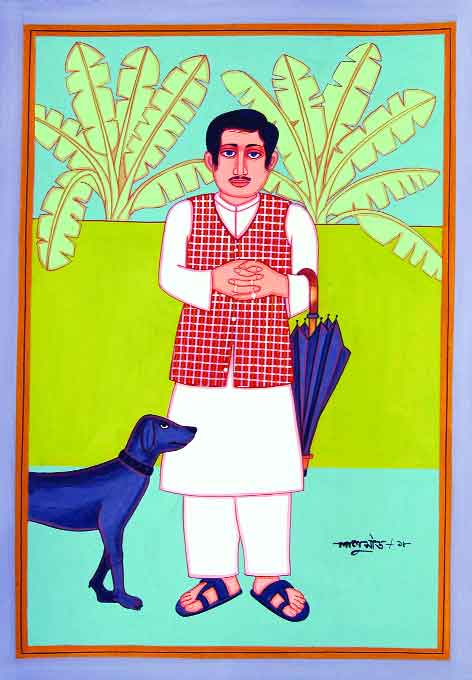Diverse elements sometimes create a composite whole. So if you piece together Lalu Prasad Shaw’s simple albeit sophisticated paintings with Tapas Biswas’s panoramic study of the skyline of the Benares Ghats and Asim Paul’s A Happy Family, a bronze that takes us back to the works of Henry Moore and Sudip Roy’s stunning abstraction with steel and canvas, you can get a glimpse of the creativity contemporary practitioners who have contributed to the making and evolution of Indian art.
These works will be showcased by the Aakriti Art Gallery from Kolkata at the 11th edition of Indian Art Fair. They showcase a wonderful process and spirit that provoke a dialogue that will not only question our own notion of culture but will also affect how we imagine ourselves.
Thus from a profusion of options, the gallery has distilled a coherent and positive selection. “Enormous care has been taken through exhibitions like ‘Gen Next’ to put contemporary Indian and international art before the public in a balanced and coherent manner. Though its emphasis has largely been on Indian art in particular, it has also showcased meaningful works from abroad at regular intervals,” says Vikram Bachawat, director of the gallery.
“Presently, we find ourselves in the moment of transit where space and time cross to produce complex figures of difference and identity, past and present, inside and outside, inclusion and exclusion that centre on the notion of displacement, migration and identity. The artists locate the subversion of art practice in the interstices of urban spaces and beyond,” adds Bachawat.
Of great intrigue and interest are Lalu Shaw’s Babu, Sudip Roy’s abstraction with steel and canvas, Tapas Biswas’s bronze of Benares Ghat and Asim Basu’s A Happy Family.
Sudip Roy’s abstraction with steel and canvas
Colour bathes, breathes and bleeds as you spy the grooves and clear passages in a celebratory steel and canvas work that reads like fragments from time. There are capacious sweeps of colour, drawing simultaneously on inert perceptions with a light hand and the dulcet design of colour’s vapid vacuous tonality Sudip adds a footnote to the history of abandoning, realism and merging it with the the magic of abstract expressionism.
When told that his works are evocative like musical passages born out of a raga, Sudip states, “ I listen to classical music all the time. I believe that the most important element in music is the sur and the shruthi. And once you listen to it, you are immersed in its nuances and its different realms.”
When you think of the different parts of the composition the lyrical flow appears seamless as it has no form. Its expanse is like a colour field of memory that is flowing just like a river.” When I began abstraction this was the surge that I witnessed. It was about the moods and momentum that was created within the web of alaaps and antaras. And it became a journey that filled me with the silence of the depths of melody and rhythm,” he affirms.
The work is an amalgamation of expansive colour fields that make curiously inviting tonal graphs of sites frequenting a certain perception that continues to coax abstraction from almost mesmeric moody moments. These have been stirred from inner recesses of the magical manipulations of time’s tenets. The swish and sweep of the brush makes you think of land and sea, which mirrors not just the brink of an epiphany but the rites of time in life.
Lalu Prasad Shaw’s Babu
A noteworthy aspect of Lalu Prasad Shaw’s paintings is their simplicity. One observes a seamless synthesis of different stylistic elements to achieve a phenomenal effect. Known widely for his highly stylised portraits of Bengali women and couples, his works focus on his subject’s physical characteristics.
This senior artist draws his inspiration primarily from nature and the milieu surrounding the great Bengali middle class, often depicting pleasant and quiet scenes from his own life on canvasses and papers. Shaw’s style is unique and modern in its adaptation of academic and traditional Indian formats. His single figures are done in an indigenous yet very sophisticated style.
Tapas Biswas’s Benares Ghat
Sculptor Tapas Biswas is one of the finest among the younger crop of sculptors in Bengal. His Benares Ghat is a panoramic study of the skyline that we see on the banks of the ancient city. What is fascinating is the manner in which he stacks up the relief features on the single piece of bronze thereby giving an illustration of a landscape. Details and elements become the leitmotif of this brilliant bronze.
Asim Basu’s A Happy Family
This is yet another brilliant bronze, where the fusion of three pieces into a single one is an idea that takes us back to the works of Henry Moore. The only way Basu differs is in his compositional structure and the cubist idiom becoming more imperative than the realist.
Writer: Uma Nair
Courtesy: The Pioneer








 OpinionExpress.In
OpinionExpress.In















Comments (0)